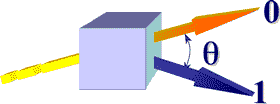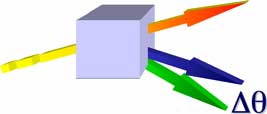ACOUSTO-OPTIC GLOSSARY
Bragg cell:
A device using a bulk acousto-optic interaction (eg. deflectors, modulators, etc...).
“Zero” order,”1st” order:
The zero order is the beam directly transmitted through the cell. The first order is the diffracted beam generated when the laser beam interacts with the acoustic wave.
Bragg angle  :
:
The particular angle of incidence (between the incident beam and the acoustic wave) which gives efficient diffraction into a single diffracted order. This angle will depend on the wavelength and the RF frequency.
Separation angle  :
:
The angle between the zero order and the first order.
RF Bandwidth  :
:
For a given orientation and optical wavelength there is a particular RF frequency which matches the Bragg criteria. However, there will be a range of frequencies for which the situation is still close enough to optimum for diffraction still to be efficient. This RF bandwidth determines, for instance, the scan angle of a deflector or the tuning range of an AOTF.
Maximum deflection angle  :
:
The angle through which the first order beam will scan when the RF frequency is varied across the full RF bandwidth.
Rise time  :
:
Proportional to the time the acoustic wave takes to cross the laser beam and, therefore, the time it takes the beam to respond to a change in the RF signal. The rise time can be reduced by reducing the beam's width.
Modulation bandwidth  :
:
The maximum frequency at which the light beam can be amplitude modulated. It is related to the rise time - and can be increased by reducing the diameter of the laser beam.
Efficiency  :
:
The fraction of the zero order beam which can be diffracted into the “1st” order beam.
Extinction ratio:
The ratio between maximum and minimum light intensity in the “1st” order beam, when the acoustic wave is “on” and “off” respectively.
Frequency shift (F):
The difference in frequency between the diffracted and incident light beams. This shift is equal to the acoustic frequency and can be a shift up or down depending on orientation.
Resolution (N):
The number of resolvable points, which a deflector can generate - corresponding to the maximum number of separate positions of the diffracted light beam - as defined by the Rayleigh criterion.
RF Power  :
:
The electrical power delivered by the driver
Acoustic power  :
:
The acoustic power generated in the crystal by the piezo-electric transducer. This will be lower than the RF power as the electro-mechanical conversion ratio is lower than 1.
AA Opto-Electronic 18, rue Nicolas Appert 91898 Orsay France
Tél: +33 (0)8 11 09 76 76 - +33 (0)1 76 91 50 12 - Fax: +33 (0)1 76 91 50 31
email:
sales@a-a.fr -
www.aaoptoelectronic.com




